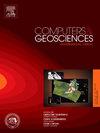LABQ3: Bayesian method for quantification of mineral compositions and nano-scale elemental mapping of 3D synchrotron XCT data
IF 4.2
2区 地球科学
Q1 COMPUTER SCIENCE, INTERDISCIPLINARY APPLICATIONS
引用次数: 0
Abstract
Quantitative analysis of mineral compositions is essential in understanding geochemical, mineralogical and environmental processes. Fine-resolution 3D imaging is widely done using synchrotron X-ray computed tomography (XCT), but existing analyses are limited to visualization and segmentation. This paper presents a new method, Linear Attenuation Bayesian Quantitative 3D-mapper (LABQ3), based on the linearity of X-ray attenuation with respect to elemental concentrations. To address the random variability in attenuation measurements, LABQ3 employs Bayesian decision theory to minimize classification error, using reference attenuation distributions from scans of pure mineral standards. To demonstrate LABQ3 and test its performance, we studied precipitated carbonate samples. XCT scans were done at multiple energies using the transmission X-ray microscope (TXM) at beamline 32-ID-C of the Advanced Photon Source at Argonne National Laboratory. The reconstructed 3D images have a voxel size of 20 nm. Analyses revealed rich nano-scale compositional heterogeneity within individual particles. A mixture of calcium and cadmium produced an overall stoichiometric composition of (Ca0.78,Cd0.22)CO3, with some voxels containing nearly pure CdCO3. The addition of zinc led to an overall stoichiometric composition of 33% Ca, 28% Cd, 39% Zn, with a nearly pure CaCO3 core and compositional zonation through the rim. These compositional gradients are related to temporal sequences of carbonate mineral formation where Cd precipitated at the beginning in (Ca,Cd)CO3, while Cd and Zn precipitated at the end in (Ca,Cd,Zn)CO3. Results differ from bulk analyses using Inductively Coupled Plasma-Mass Spectrometry (ICP-MS), showing that LABQ3 provides particle-specific insights. LABQ3 distinguishes itself by quantifying chemical compositions along a continuum, making it different from XCT analyses based on segmentation. LABQ3 allows simultaneous acquisition of morphology and chemical composition in 3D, facilitating the interpretation of chemical gradients of trace elements, quantification of solid solution compositions, inferences about temporal sequences of mineral precipitation, and addressing other concerns about solid-phase chemistry.

LABQ3:三维同步加速器XCT数据中矿物成分定量和纳米尺度元素映射的贝叶斯方法
矿物组成的定量分析对于理解地球化学、矿物学和环境过程是必不可少的。高分辨率三维成像广泛应用于同步加速器x射线计算机断层扫描(XCT),但现有的分析仅限于可视化和分割。本文提出了一种基于x射线衰减与元素浓度线性关系的新方法——线性衰减贝叶斯定量三维映射(LABQ3)。为了解决衰减测量中的随机变异性,LABQ3采用贝叶斯决策理论来最小化分类误差,使用纯矿物标准扫描的参考衰减分布。为了证明LABQ3并测试其性能,我们研究了沉淀碳酸盐样品。在阿贡国家实验室先进光子源的32-ID-C光束线上,使用透射x射线显微镜(TXM)在多个能量下进行XCT扫描。重建的三维图像体素尺寸为20nm。分析表明,单个颗粒内具有丰富的纳米级成分异质性。钙和镉的混合物产生了(Ca0.78,Cd0.22)CO3的总体化学计量组成,其中一些体素含有几乎纯的CdCO3。锌的加入使其整体化学计量组成为33% Ca, 28% Cd, 39% Zn, CaCO3核接近纯,并通过边缘组成带。这些组成梯度与碳酸盐矿物形成的时间序列有关,Cd在(Ca,Cd)CO3中开始沉淀,Cd和Zn在(Ca,Cd,Zn)CO3中结束沉淀。结果不同于使用电感耦合等离子体质谱(ICP-MS)的大量分析,表明LABQ3提供了粒子特异性的见解。LABQ3通过沿着连续体定量化学成分来区分自己,使其与基于分割的XCT分析不同。LABQ3允许在3D中同时获取形态和化学成分,促进微量元素化学梯度的解释,固溶体成分的量化,推断矿物沉淀的时间序列,并解决有关固相化学的其他问题。
本文章由计算机程序翻译,如有差异,请以英文原文为准。
求助全文
约1分钟内获得全文
求助全文
来源期刊

Computers & Geosciences
地学-地球科学综合
CiteScore
9.30
自引率
6.80%
发文量
164
审稿时长
3.4 months
期刊介绍:
Computers & Geosciences publishes high impact, original research at the interface between Computer Sciences and Geosciences. Publications should apply modern computer science paradigms, whether computational or informatics-based, to address problems in the geosciences.
 求助内容:
求助内容: 应助结果提醒方式:
应助结果提醒方式:


